

We simulate viscoelastic phase separation of polymer solutions by solving numerically Langevin equations of a viscoelastic model that newly includes the bulk relaxation modulus in addition to the shear relaxation modulus. The results reproduce almost all the essential features of viscoelastic phase separation observed experimentally: (i) The existence of a frozen period, the nucleation of the solvent-rich phase, (ii) the volume shrinking of the polymer-rich phase, (iii) the transient formation of a networklike structure, and (iv) the phase inversion in the final stage. Our simulations clearly indicate that the bulk stress is responsible for (i), (ii), and (iv), while the shear stress for (iii).
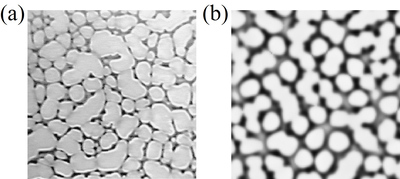

We have studied the characteristic features of viscoelastic phase separation in three dimensions by using numerical simulations, focusing on the morphological development. The Langevintype equations of a two-fluid model, which includes both bulk and shear viscoelastic stresses, are solved numerically. The origin of phase inversion is discussed on the basis of a simple consideration on the symmetry of the effective phase diagram, and the importance of the bulk stress on this phenomenon is addressed. The roles of bulk and shear stresses are clarified by comparing simulation results for cases with and without each stress. We analyzed the temporal change in the structure factor and found that the structure factors cannot be scaled, and thus, the dynamical scaling law does not hold at all for viscoelastic phase separation. We also studied the geometrical characteristics such as the mean and Gaussian curvatures and the Euler characteristic of the interface, to characterize the topological features of viscoelastic phase separation. The results also unambiguously indicated the absence of the selfsimilarity, which is the central concept of the late-stage pattern evolution in conventional phase separation. The topological change accompanied by phase inversion was successfully characterized by the curvature of domain interface and the Euler charactristic. Our study indicated the advantage of the real-space analysis over the q (wavenumber)-space one in the topological characterization.
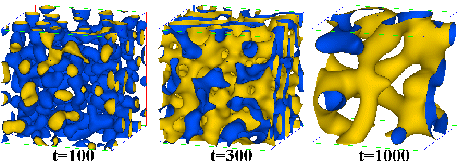
Viscoelastic phase separation is characterized by the formation of a transient gel upon phase separation. A transient gel state is widely observed in complex fluids including polymer solutions, colloidal suspensions, and protein solutions, but its physical description is quite difficult due to its intrinsically nonequilibrium nature. We have modeled this transient gel state using a type of Brownian dynamics simulation in which coarse-grained particles interacting with a Lennard-Jones potential are connected by elastic springs, which can be disconnected with the probability controlled by the ratio of the stored elastic energy to the thermal energy. The simulations well reproduce pattern evolution in a transient gel of a polymer solution. Our simulations indicate that domain morphology is controlled by two key physical factors: (i) the ratio between the nucleation and growth rates of domains of the less viscoelastic phase and (ii) the fragility of the transient gel.
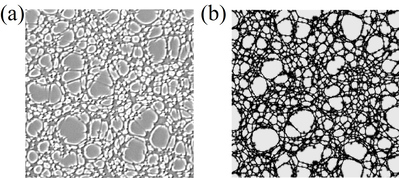
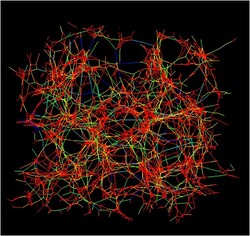
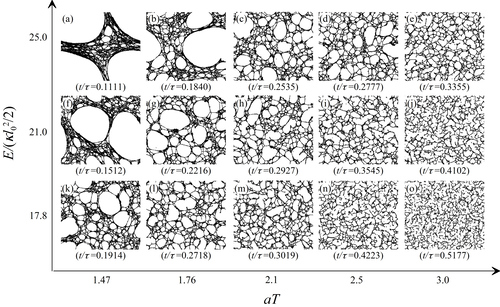
Dynamic equations are presented for polar binary mixtures containing ions in the presence of preferential solvation. In one phase states, we calculate the dynamic structure factor of the composition accounting for ion motion. Microphase separation can take place for sufficiently large solvation asymmetry of the cations and the anions. We show two dimensional simulation results of the mesophase formation with an antagonistic salt, where the cations are hydrophilic and the anions are hydrophobic. The structure factor $S(q)$ in the resultant mesophase has a sharp peak at an intermediate wavenumber of the order of the Debye-Huckel wavenumber. As the quench depth is increased, the surface tension nearly vanishes in mesophases due to an electric double layer.
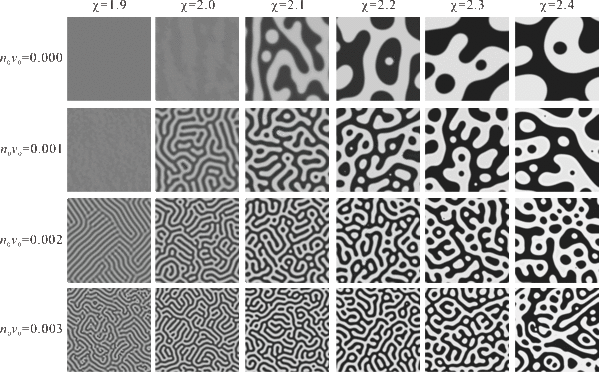
We demonstrate by numerical simulations that spinodal decomposition of fluid mixtures is strongly dependent upon their fluidity, which characterizes the relative importance of the two relevant transport mechanisms, hydrodynamic flow and diffusion. Thus, it may not be universal, at least in two dimensions. For a high fluidity, we find spontaneous double phase separation. We confirm that this unusual phenomenon is caused by the following mechanism: High fluidity causes rapid geometrical coarsening of domains due to a hydrodynamic process, which is too fast for diffusion to follow. This brings the system out of equilibrium and induces secondary phase separation.
